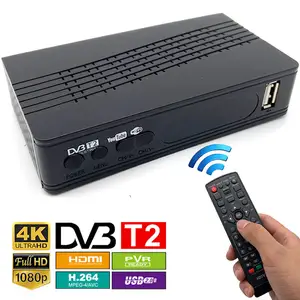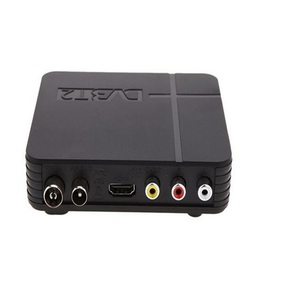(2650 products available)


























































































































































































































DVB T2 MPEG4 is a type of digital terrestrial television. MPEG4 is used as the video codec for this digital terrestrial television. This television is transmitted through the air to a rooftop or indoor antenna. MPEG4 is a type of compression technology used to compress the video and audio. It is a newer and more efficient type of compression technology than MPEG2, which is used in older analog TV signals. MPEG4 allows for higher quality video and audio to be transmitted over the air, which is not possible with MPEG2.
There are different types of DVB T2 MPEG4 television sets, and they are classified according to screen size. The 19 inch DVB T2 MPEG4 TV has a screen size of 19 inches, the 32 inch DVB T2 MPEG4 TV has a screen size of 32 inches, the 40 inch DVB T2 MPEG4 TV has a screen size of 40 inches, the 43 inch DVB T2 MPEG4 TV has a screen size of 43 inches, the 50 inch DVB T2 MPEG4 TV has a screen size of 50 inches, the 55 inch DVB T2 MPEG4 TV has a screen size of 55 inches, the 60 inch DVB T2 MPEG4 TV has a screen size of 60 inches, the 65 inch DVB T2 MPEG4 TV has a screen size of 65 inches, and the 75 inch DVB T2 MPEG4 TV has a screen size of 75 inches. The 19-inch DVB T2 MPEG4 TV to the 43-inch DVB T2 MPEG4 TV is considered to be small, the 50-inch DVB T2 MPEG4 TV to the 60-inch DVB T2 MPEG4 TV is considered to be medium, and the 65-inch DVB T2 MPEG4 TV to the 75-inch DVB T2 MPEG4 TV is considered to be large.
There are also different types of DVB T2 MPEG4 TVs according to display type. They are categorized into normal display type and 3D display type. The normal display type is a flat panel display in which the monitor or TV is not curved. The 3D display type is a flat panel display that provides a 3D image without the need for 3D glasses or other 3D equipment.
DVB-T2 MPEG4 is used to broadcast TV signals and provide a wide range of services. Here are some of the applications of DVB-T2 MPEG4:
One of the key applications of DVB-T2 MPEG4 is to provide high-quality television content to viewers. With the ability to support high-definition video and audio, DVB-T2 MPEG4 enables broadcasters to deliver crisp, clear images and immersive sound, enhancing the viewing experience for audiences. Whether it's sports, movies, or nature documentaries, viewers can enjoy stunning visuals and surround sound through DVB-T2 MPEG4-compatible devices.
Another important application of DVB-T2 MPEG4 is to enable mobile TV services and portable TV reception. DVB-T2 MPEG4 allows broadcasters to optimize their signals for transmission to mobile devices like smartphones, tablets, and handheld TVs. By using efficient video compression and robust transmission technologies, DVB-T2 MPEG4 makes it possible to watch TV on the go, whether traveling, commuting, or enjoying outdoor activities. Additionally, DVB-T2 MPEG4 supports the creation of portable TV receivers with compact antennas, so users can access television programming anywhere, even in areas without traditional TV coverage.
DVB-T2 MPEG4 supports interactive services that engage viewers and provide additional content. Through DVB-T2 MPEG4, broadcasters can offer features like electronic program guides (EPGs), on-demand video streaming, interactive applications, and supplementary information. Viewers can use the EPG to browse schedules and select programs for recording. On-demand services allow users to watch movies and shows whenever they want. Interactive applications provide entertainment and educational experiences. Supplementary information enhances the viewing experience with details about programs, such as cast biographies and episode summaries. DVB-T2 MPEG4 enables a rich multimedia environment that goes beyond traditional television, offering a wide variety of content and features for audiences to enjoy.
To choose a DVB-T2 MPEG4 receiver to meet the needs of a target market, it is necessary to perform an environmental scan to determine the number of broadcasters in a particular area. Additionally, one must identify the type of MPEG-4 codec being used. If the broadcaster is not confirmed to be using the MPEG-4 codec, the current DVB-T model should be used for the meantime. Also, confirm the type of content that the target market will be viewing. This includes determining if the content is HD or SD. If the content is mostly HD, then a DVB-T2 receiver will be needed. The target market will also influence the decision of what type of receiver to get. For example, if the target market is people who travel for work, then a portable receiver will be needed. Research should also be done on the kind of televisions used by the target market. This will help determine if a receiver is needed to convert a digital signal into an analog signal. When choosing a receiver, one must also check if it supports encryption systems. This is important because some receivers do not support the same encryption systems. To meet the needs of the target market, it is important to choose a receiver that supports the same encryption system as the broadcaster. The price is an important factor to consider when choosing a receiver. However, it is important to remember that a higher price does not always indicate better quality. When choosing a receiver, it is important to ensure that it is user-friendly. This is because not all customers are tech-savvy. It should be easy for them to install and use the receiver. Furthermore, it should be easy for customers to access the menu and change the channels. It should also be easy to ensure that all the features of the receiver work together seamlessly. To ensure that a receiver can be used in the target market, it is important to check if it supports the same power plug and voltage. One must also ensure that the receiver can work under the same temperature conditions. It is also important to ensure that the receiver is portable. When choosing a receiver, the weight and size should be considered. If the receiver is too heavy and large, it will be difficult for customers to carry it while traveling. It is also important to consider the type of display output that the receiver has. This will help determine if it can be connected to a computer monitor, TV, or other devices. Most receivers have an HDMI output that allows them to be connected to a TV. Some also have an RCA output that allows them to be connected to a TV. In addition, one should also consider the type of connectivity options that the receiver has. Most have a USB connection that allows them to connect to a flash drive. Some also have an Ethernet port that allows them to connect to the internet. This allows customers to access digital content on the internet. One should also consider the number of tuners that the receiver has. The more tuners a receiver has, the more content that can be recorded. For example, a receiver with two tuners can record two programs at once. Some receivers also have a PVR feature. This allows programs to be recorded on the hard drive. This is a great feature for customers who are not at home to watch the programs when they are airing. A receiver with a PVR feature is a better option than one without.
Q1: What is the difference between DVB-T2 and DVB T2 MPEG4?
A1: DVB-T2 is a technical standard for the digital transmission of television audio and video, while DVB-T2 MPEG4 is a codec, where the T2 symbolizes the second generation. The DVB-T2 standard uses the H.264/MPEG-4 AVC codec for video. This combination offers better video compression and picture quality than the older DVB-T standard, which used the MPEG-2 codec.
Q2: What is DVB T2 MPEG4 receiver called?
A2: A Digital Video Broadcasting - Terrestrial Second Generation/Moving Picture Experts Group Part 14 (DVB-T2/MPEG-4) receiver is also called a set-top box.
Q3: Is MPEG-4 better than MPEG2?
A3: MPEG-4 has an advantage over MPEG-2 in that it offers better compression, which means that the same content takes up less storage space without any loss in quality. However, this will only be the case if the codec is used properly.
Q4: Is DVB T2 MPEG4 HD?
A4: DVB-T2 is an abbreviation for Digital Video Broadcasting – Second Generation Terrestrial; it is the extension of the television standard DVB-T and specifies the use of the H.264/MPEG-4 AVC compression.